You can live your entire life next to a city and never go there if you don't really have a reason. I'm from Dnipropetrovsk, and it took me quite a while to make my first trip to Donetsk. As I began my first walk in the city, I contemplated its perceived image and set out to either find supporting evidence or dispel common stereotypes about it.
Myth 1. Donetsk is unattractive to tourists
Before going to Donetsk you need to refocus your tourist glasses and literally learn to see the special character and beauty of this city. Industrial tourism buffs will not be disappointed. Approaches to the city feature sprawling metallurgical giants, lengthy rows of chimerical constructions pinned to the sky by a forest of smokestacks. Scattered bursts of flame over these industrial monsters make them look like fire-breathing dragons. In a while these man-made giants will definitely become industrial tourism attractions. If they stand for a couple more decades, UNESCO may take these remarkable specimens of industrialization under its protection like they did for metallurgy plants in Germany’s Ruhr Region.
Riding a tram around the city, I can see the glowing Donbas Arena stadium emerging against the background of the city's pit refuse heaps. Surrounded by grass lawns, the arena is has become a pearl in the cityscape and the hottest place to go in Donetsk. Glamorous local girls spend hours on end in its fitness centers and cafés. Guests also often come here to take advantage of several thematic soccer-related tours. I buy fridge magnets for all my friends with Dmitri Mendeleev’s words: “Donetsk. Opportunity proved by action.”
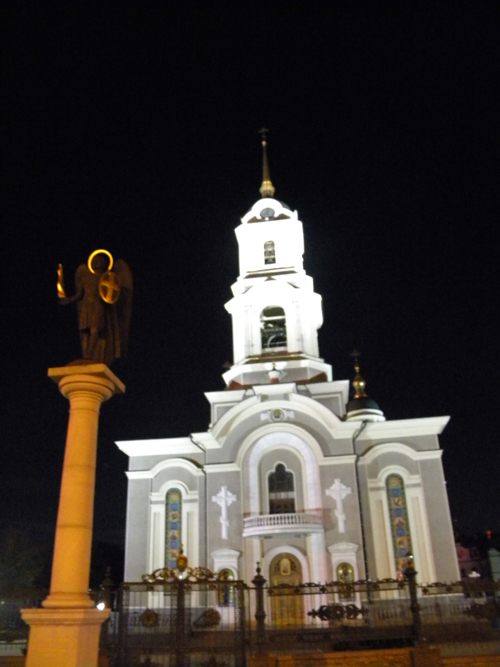
2. Donetsk is gray and dirty
Apart from its multitude of heavy industry complexes, Donetsk has many public gardens, grounds carefully planted with greenery, fountains, and a forged-metal figure park. The Donetsk Botanical Garden occupies over 250 hectares. In Soviet times, Donetsk was called the city of a million roses. You may think that this is just a metaphor, but no — municipal authorities have reported, for two years now, great progress in “rosifying” Donetsk on the way to regaining this status. The rose is the city's symbol and the flowers feature heavily in the park of forged-metal figures.
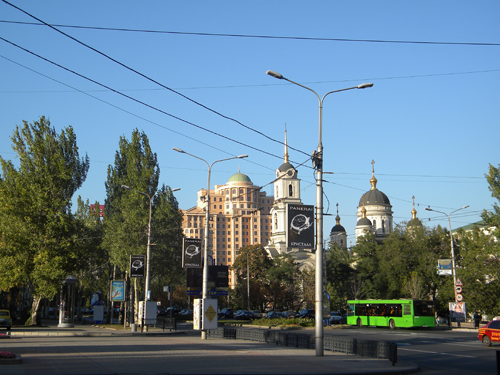
3. Donetsk lacks comfort.
Apart from pit refuse heaps, there are bodies of water within city limits: the large Kalmius River, four small rivers, numerous ponds, and six water preserves of which one has the lofty name Donetsk Sea. I go along the bridge over the First City Pond with pale-green pavilions along its banks and head for Oleksandr Shcherbakov Central Park. From this bank I can see remote parts of the city, TV towers, and the quaint roof of the circus that looks like a mammoth cycle track. Standing on the bridge, local anglers catch small fish to sell on the spot at UAH 5 a bag.
Fairly modern trolley buses run along the smooth and roads free of potholes. In new tramways, the stops are announced via scrolling text — Kyiv with its antediluvian trams would be green with envy. The next stop lights up: it’s Young Coalminers Str. I immediately forget everything about envy as I remember how many Donetsk coalminers die in mines each year.
4. Connections decide everything in Donetsk.
There is a huge flowerbed between me and a woman sitting on a bench on the other end. She gets up, goes around the flowerbed, and after a little zigzag walks directly toward me and starts speaking. She doesn’t see my eyes behind dark glasses, but then she is seeing me for the first time anyway. She decide to approach me because I am her daughter's age. She has come to have some medical tests performed in a private clinic and the rude staff there has made her late for work. She says people who know the doctors personally have been skipping the line. She is now thinking about what to do next rather than trying to swallow the bitter pill. She would need to wait for those nurses after work and “reward” them for their disrespect. After complaining about life and letting tears stream down her cheeks, she leaves as suddenly as she came. I don’t know if she was one bit consoled by my listening to her.
Students stop in front of stands offering information about the city and exchange impressions: “Look, the mayor has seven deputies!”
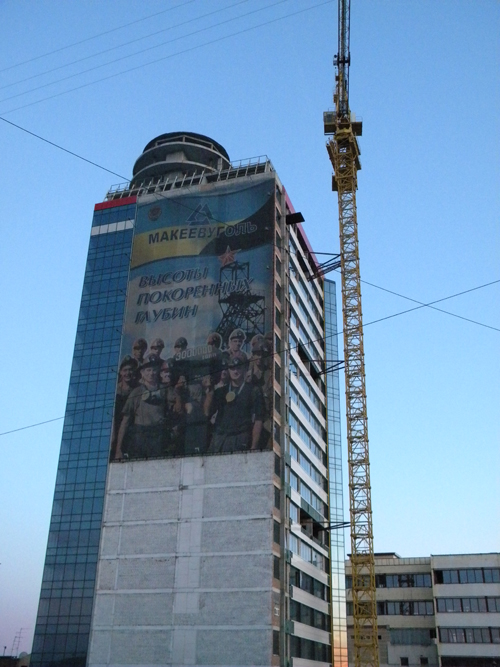
5. Donetsk doesn’t have interesting architecture.
As you go to Donetsk, you don’t exactly expect to feast your eyes on the local architecture. But the city has turned out to be nicer than what I expected to see — it is young (just 141 years old) and is in good shape. Eastern Ukrainian cities doing their best to outgrow Soviet-era architecture, and what they do sets them apart. Donetsk does not sprawl before your eyes to the point of disintegrating as a city like Zaporizhzhia does. Nor is it spangled all over with glass structures like Dnipropetrovsk. The local Stalin-era buildings here are inlaid with the huge windows of modern shops, while empire-style columns sport the adverts of expensive brands.
The city center is governed by architectural eclecticism, so even a balcony of a small post-war building sitting between newly built high rises commands admiration. Admiring what you see may simply be a bad habit. My gaze is attracted by features of unfamiliar everyday surroundings, bizarre steaming hot-water pipes, and the gracious constructivist windows of staircases, which are sometimes called thermometer windows. In a word, these are the things that are never found together anyhere else in combinations like these.
I come across a market with a dome-shaped roof built in 1957 — a true architectural rarity! Plaques of regional offices of pro-Russian parties shine on its façades. Here is the branch of a private pension fund. Ads glued to the wall invite you to attend meditation sessions and use the services of the “first chiromancer in Donetsk.” Boys dressed in white suits and gloves are lined up before the front door of Donbas Palace — they must be waiting to welcome some important guest.
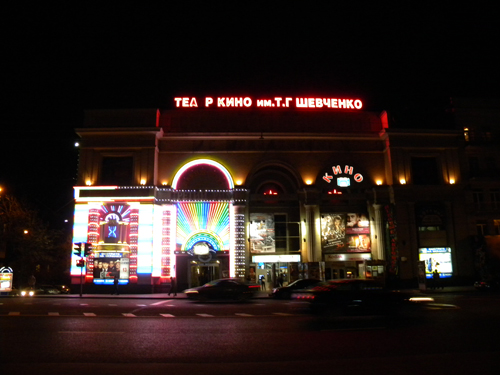
6. Donetsk is a preserve of Soviet-time toponyms.
Donetsk was previously called Stalino, Yuzivka, and Trotsky (in 1923). Soviet place names still dominate in the city, for example, Artema Str., the Nadezhda Krupskaya Oblast Library, Zoya Kosmodemyanskaya Ave., Vatutin Ave., Dzerzhinsky Ave, etc. Meanwhile, an initiative to name Donetsk National University after poet Vasyl Stus.
7. Donetsk is a proletarian city.
“There are many universities, professors, and students in Donetsk — it is a fairly intellectual city,” says Oleksii Zaretsky, who came here from Kovel in 1995 and stayed after completing studies in the philharmonic society. “Moreover, Donetsk has revamped its image in the past eight to 10 years and turned into an absolutely European city.” As he says this, we pass the Lenin monument that no one is ever going to remove here. “I was once going by this monument with my son, and he asked me about who the man was,” says Oleksii. “I told him and mentioned all of Lenin’s flaws. To this my son replied: ‘Well, grandma said that grandfather Lenin was a good man.’”
8. Wives of Donetsk businessmen are housewives.
I return to Kyiv by train and find myself in one compartment with Lora, an extremely nice-looking blonde. As she changes into her strass-dotted sports suit, she seems to be a typical wife of a Donetsk businessman decked out in brand-name clothing. Upon closer acquaintance, however, this typical image yields to a real personality. In addition to her several higher educations, it turns out that the guys from my favorite Donetsk band Bosiaky were her fellow students at Donetsk Polytechnic University. She now works in the fashion industry and has the chance to travel around the world. She shares her opinions right off the bat: Japan is orderly, Asia is immoral, Paris is full of fashion weeks, etc. She is a true citizen of the world with a Donetsk address. Both Lora and her children feel at home in this world that is inaccessible to many. “My daughter knows her way around Tokyo and Paris but can get lost in Donetsk,” she says.
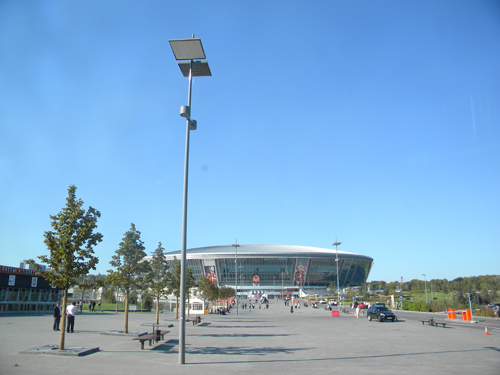
9. Donetsk residents support the current government and hate Ukrainian.
As I speak with Lora, my stereotypes are dispelled. She remembers that after coming from Russia’s north regions, she did not understand Ukrainian, but she tells her children that they can’t have too much knowledge. HYPERLINK "http://tyzhden.ua/News/15513" Donbas Arena often hosts concerts after soccer games, and these have already included performances by Lama and Tartak. Thankful Donetsk residents sang along. In a flashback, I see with my inner eye the graffiti on a wall in Donetsk which reads: Love Ukraine! The author, poet Volodymyr Sosiura, was born precisely in the Donbas.
After a split second, Lora admits that she doesn’t respect the current government: “After the election, tax inspectors came to my husband’s firm and demanded that he pay a large sum — just like that, for nothing.”
10. Donetsk is bloated in ostentatious ambitions.
Donetsk is an ambitious city all right and aspires to have its palm, even if it is Mertsalov Palm. Donetsk has only a replica of this masterpiece of blacksmith art – the original is in a Saint Petersburg museum. I tell Lora about my first and most vivid impression of the city: a superexpensive car stops in front of offices in the central square and a stylishly dressed handsome man gets outs. Lora starts guessing who he was — she knows all local high-brows. I think about the luxurious offices and beautiful one-storied buildings in downtown Donetsk that could as easily be standing in the center of Sopot or Leipzig. I also remember the news that a house on the embankment along the Kalmius is to get Donetsk’s first helicopter landing site. “Everyone here loves to show off. If vain ambition shined, Donetsk would shine like Las Vegas,” says Lora.
I remember these words when I hail a taxi near a Boom supermarket. Full of light, the square looks like an anthill: expensive cars arrive and leave the parking area; families with children walk on sidewalks. The street is loud with live singing in a nearby restaurant punctuated by fireworks that will continue to explode for another 20 minutes at least. The children are running around and screaming in delight. The loud bursts trigger anti-theft alarms in parked cars, and I drown in all this noise. I can’t hear my phone: Donetsk is all around me, whirling, throbbing, and roaring. The families get tired of looking up into the sky and leave only to be replaced by others, and this goes on and on in an endless train. Finally, my taxi arrived and after I get in, we ride off on the smooth ideal Donetsk roads with the roar of the city still resonating in my ears.

